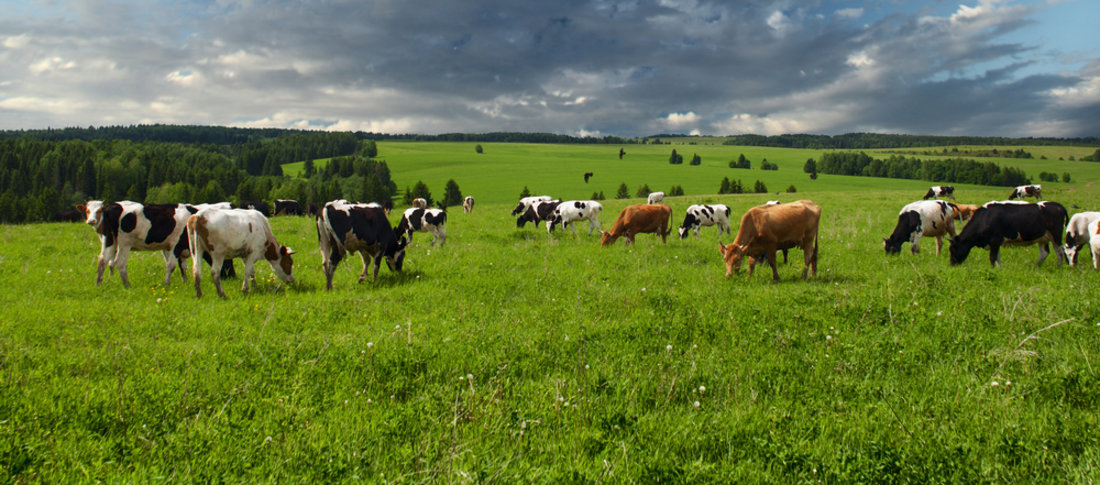There’s no doubt about it. After a long winter indoors, your cows will be seriously excited to get back to grazing the green pastures. But turnout requires some careful planning if you want to keep your herd happy. The good news is that nutritional best practice will help cows enhance milk production, maintain body condition and increase fertility. Sounds good? Here are some tips.
Choose your first field carefully
It goes without saying. Cows love munching on grass. That cuts your feed costs and gives your cows a nutritional kick too. There’re high amounts of those ever-topical omega-3 fatty acids in springtime ryegrass.) But which fields should you set your herd free in first?
The best options to choose are those that haven’t been grazed since late September or early October, with a sward length of around 8-10cm. Match the stocking density to the soil conditions, avoiding damp soils in favour of dry and light soils.
Once the sward length has been grazed to 5-6cm it’s time to move your herd to a different field while the grass recovers. This allows sunlight to enrich the next grass tillers and clover plants and boosts sward production.
Finding the fertiliser formula
To fertilise or not to fertilise? That is your decision. But if you choose to sow, know that grass responds best to nitrogen fertiliser when soil temperatures at 10cm are higher than 5oC for a minimum of four consecutive days. Applying 50kgs of nitrogen fertiliser per hectare in areas that favour early growth (well-drained south-facing slopes with light soils) will ensure your cows have plenty to chew on come turnout time. Avoid fertilising in wet conditions. You don’t want wheels damaging your fields.
Test the nutritional value of your fields
Grass is low in magnesium, while lactating cows also lose magnesium in milk. It’s a double whammy that can lead to grass staggers (or tetany): a potentially deadly condition that can take hold rapidly. Grass staggers is caused by magnesium deficiency and dairy cows are particularly susceptible at turnout.
Magnesium supplements provide an effective way to protect your herd. To identify how much magnesium and other nutrients are needed, test the nutritional value of your soil and grass. That way you will know exactly how best to optimise your herd’s nutrition for health, productivity and profit.
Be careful of overuse of potash fertiliser, which interferes with magnesium uptake and can increase the risk of grass staggers.
Don’t lose focus on fats
Fat is crucial to cowkind. In fact feeding the right type of fats, in the right quantity has been proven to improve fertility and increase milk yields. So how do you make sure your herd is getting enough of it?
>> More fat, more profit: are you feeding enough fats to your dairy herd?
High-yielding dairy cows may need around 6-8% fat in the dry matter to remain productive, fertile and healthy. Grass can only provide around 3% of that, so it’s worth considering a well-chosen fat supplement.
Megalac’s range of dietary supplements have been proven to increase milk yield, milk fat yield and milk protein yield. The latest addition to the range, Mega-Max, utilises the latest research on dairy cow nutrition to provide the ideal balance of fatty acids to optimise milk yield while minimising loss of body condition.
Watch the launch of Mega-Max at EuroTier 2018 here.
Mega-Max combines C16:0 (palmitic acid) and C18:1 (oleic acid) to balance milk production and body condition during the critical early lactation period. In a nutshell, the oleic acid helps to prevent body condition losses during early lactation and thus contributes to enhanced fertility, while promoting egg quality and embryo development. In the later stages of lactation the C16:0 fatty acids improve milk yield.
It’s this combination that makes Mega-Max an ideal one-product answer to dairy farmers’ fat supplementation challenges. And because Mega-Max is a rumen-protected fat supplement, there’s no negative impact on digestive function that can occur when you overfeed fats from more-traditional feed ingredients.
>> How to maintain a healthy rumen in dairy cattle
Plenty of water
Don’t forget about the wet stuff; a crucial part of the nutritional puzzle. After turnout from winter housing, it becomes harder to monitor your herd’s water intake. Yet good hydration is crucial to good milk yields and dairy cows require large volumes of water - high-yielders may guzzle 100 litres or more each day. So make sure troughs are well-maintained and spread generously around your fields, dairy and feedout areas.
Over to you...
- At turnout time choose your first field carefully - light soil and a sward length of 8-10cm is key
- Once sward length has been grazed to 5-6cm, move your herd to a different field and allow the grass to recover
- Optimise the effectiveness of nitrogen fertiliser by applying when soil temperatures have been a minimum of 5oC for four consecutive days
- Use a magnesium supplement to protect against tetany
- Consider a well-chosen fat supplement such as Mega-Max to boost milk yields and enhance fertility
- Ensure your grazing herd has access to plenty of water across your farm
